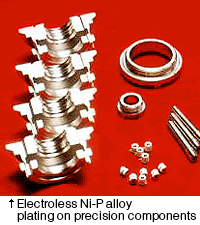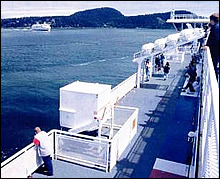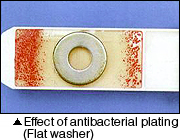The standards define industrial nickel plating and nickel electroforming for the purposes of corrosion reistance, wear resistance, and overlay build-up on steel and nonferrous metals.
(1) Classification and applications
[Table 1] shows the classification and applications of industrial nickel plating and nickel electroforming.
[Table 1] Classification and applications of industrial Ni plating and Ni electroforming
| Classification by machining process | Application examples |
| As plated | Corrosion resistive purpose, Food production equipment, Glass production rollers, etc. |
| Post plating machining | Wear resistive purpose, cylinders, shafts, etc. |
| As electroformed | Foil, Outer blades of electric razors, etc. |
| Post electroformed machining | Electroformed molds, Build-up plating on shafts, etc. |
|
| ※ | ●As plated, as electroformedNo machining process applied after plated or electroformed.●MachinedMachining processes by mechanical means are applied on plated surfaces or electroformed surfaces. |
(2) Quality
Appearances, surface roughness, thickness, hardness, wear resistance, and other required qualities of plating and electroforming are to be determined by the agreements of the involved parties.
(3) Adhesion characteristics
Tested by grinding test method, chisel driving test method, thermal test method, or tensile test method.
(4) Symbols and names of plating and electroforming
●Ep-Fe*, M/E-Ni, M, 500±10/1G, 2G(1.6 μm Ra)
Industrial nickel plating on steel surface: 500±10μm, base metal and plating are to be ground finished to a surface roughness of 1.6μm Ra.
M: machining on base metal, E-Ni: industrial nickel plating, 1G: machining before plating, 2G: grinding after plating, Ra: Center line average roughness.
| ※ | Carbon steel for mechanical structure S45CThis can be abbreviated as follows.Ep-Fe*, /E-Ni, 500±10/G, (1.6μm Ra) |
●Ef/Ni, b, 100±10/
Ef: Electroforming, Ni: Nickel, b: Gloss type electroforming
●Ep-AL*/Ni, 100±10, ICr, 10/G, (0.4μmRa)
Ep: Electroplating, AL: Aluminum alloy A5052S, Ni: Nickel plating 100±10μm, ICr,10: 10μm Industrial chrome plating, /G: Grinding finish after plating



